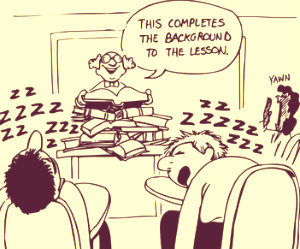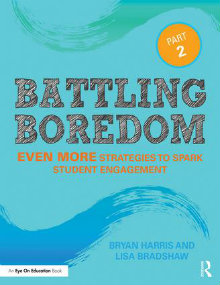Engagement Strategies That Just Don’t Work
In the books Battling Boredom and Battling Boredom, Part 2 (see our review), Bryan Harris and Lisa Bradshaw offer practical strategies to “spark student engagement.” But what about popular teaching practices that don’t work? In this post, the battle-worn duo take the opposite tack, warning us off a half-dozen frequently used techniques that are overdue for retirement.
By Bryan Harris and Lisa Bradshaw
 Although some strategies and techniques have been around for a long time, not all the “classics” are actually effective at engaging students in authentic ways. Some should be removed from regular classroom use because they increase the likelihood of disengagement.
Although some strategies and techniques have been around for a long time, not all the “classics” are actually effective at engaging students in authentic ways. Some should be removed from regular classroom use because they increase the likelihood of disengagement.
The strategies we highlight here all have one thing in common – they actually impede, slow down, or outright stop true engagement. And yet they persist.
 Even though we know that engagement is the key to learning, many of our students continue to be bored with the curriculum and activities being offered in classrooms. To battle this problem, much focus and attention has been placed on getting students to be “on-task.” Indeed, the link between on-task behavior and student achievement is strong.
Even though we know that engagement is the key to learning, many of our students continue to be bored with the curriculum and activities being offered in classrooms. To battle this problem, much focus and attention has been placed on getting students to be “on-task.” Indeed, the link between on-task behavior and student achievement is strong.
However, just as an office worker can be busy without being productive, a student can be on-task without actually being engaged in the learning. Real, long-lasting learning comes not merely as a result of being on-task, but being deeply engaged in meaningful, relevant, and important tasks.
Some students, particularly in middle and high school, have become masters at what Bishop and Pflaum (2005) refer to as “pretend-attend.” They’ve mastered the ability to look busy, focused, and on-task, but in reality they are disengaged in the actual learning.
As you consider each of the strategies described here, ask yourself this very important question: If I use this strategy, am I likely to increase or decrease authentic engagement? We believe you’ll see that they do not live up to the standards of true engagement.
Academic Decathlon
In athletic competitions the fastest and strongest individuals win. Unfortunately, many educators assume that students who are the quickest to answer questions (or the quickest to offer answers) are the smartest and should be rewarded.
The Academic Decathlon strategy is the practice of the teacher consistently calling on, rewarding, or granting privileges to those students who are the fastest to raise their hands, answer questions, or volunteer. While speed and automaticity with certain things like math facts are important, when seeking to engage students in deep, meaningful ways, the invitation needs to be open to all students, not just the “smart” kids who can answer questions quickly.
When teachers primarily seek to engage the “best academic athletes,” they send a very clear (and unfortunate) message that education, learning, and growth are for a select few individuals for whom learning comes fast and easy.
Answer Hunt
 During whole group activities such as lectures, there are times when teachers will ask questions of students in order to gauge understanding and progress. While questioning is a great way to engage students, there are times when teachers will “hunt” for a correct answer.
During whole group activities such as lectures, there are times when teachers will ask questions of students in order to gauge understanding and progress. While questioning is a great way to engage students, there are times when teachers will “hunt” for a correct answer.
Rather than re-framing the question or allowing extended think time or opportunities for students to talk with each other, the teacher resorts to “answer hunting,” rapidly calling on many students in the class until (sometimes by accident), a student answers the question correctly.
Anything with a “Robin” in it
This is the classic strategy where the teacher assigns a certain part of a text or a certain portion of an assignment to each student in the class. Typically, the teacher begins by asking one student to read their part or answer their question while the other students in the class are asked to listen and wait until their turn to participate.
Round Robin reading is probably the most common of the “robins.” This practice is ineffective for many reasons. Although the teacher intends that all students follow along until it is their turn, this approach typically results in students focusing only on completing their portion of the text.
 Consider the reality of what is likely happening in the minds of students – they are assigned a paragraph to read, they skip ahead and pre-read that paragraph to themselves, then they wait until it is their turn to read, and once their turn is over they breathe a sigh of relief and take a break. This approach all but guarantees that only one student will be engaged at any given time.
Consider the reality of what is likely happening in the minds of students – they are assigned a paragraph to read, they skip ahead and pre-read that paragraph to themselves, then they wait until it is their turn to read, and once their turn is over they breathe a sigh of relief and take a break. This approach all but guarantees that only one student will be engaged at any given time.
Many teachers have recognized the limitations of this approach and instead have implemented a strategy where reading or participation is designed to be random. “Popcorn Reading,” as it has been nicknamed, is a popular approach designed to keep students focused since the order of participation is supposed to be random and unknown.
During Popcorn Reading a student finishes their portion and then the student or the teacher randomly calls on another student in the class to read the next section. Although we would consent that the popcorn approach is better than a true Round Robin, it still all but guarantees that only one student will be participating at any given time.
Some will argue that students need to follow along in order to be able to continue the reading/problem/discussion in case they get “popcorned,” but we have seen many occasions where students get irritated, embarrassed, or outright mad at each other for being called on by another student. In addition, in most classroom settings, once a student has been called upon to participate, they rarely get called again. Students quickly learn that after their turn is complete, they can mentally check out.
Copying
 There are times when students need to copy information, but too many teachers assume that copying – in and of itself – is an engagement strategy. It is not; copying information (such as taking notes or writing dictionary definitions) does not guarantee thinking or engagement.
There are times when students need to copy information, but too many teachers assume that copying – in and of itself – is an engagement strategy. It is not; copying information (such as taking notes or writing dictionary definitions) does not guarantee thinking or engagement.
While copying may be necessary at times, what is most important is what students do with the information they have copied. It is also important to keep in mind that copying is not synonymous with writing.
Keep it short – Remember that copying can be boring and students can get fatigued very quickly. Consider carefully the most important content or concepts that students need to master and have them only copy small amounts of the most essential information.
Discuss it – Explain to students why the information is important and discuss those key ideas both before and after they have copied it.
Rewrite it – Once students have copied information and heard directly from the teacher about why it is important, they should talk about the information and then rewrite, rephrase, or summarize their understanding of the content.
Extended Lecture
Lecture is so ubiquitous – so widely used as an instructional strategy – that many educators assume it is effective. While many researchers and educators have offered excellent strategies to make lecture more engaging, it is our belief that shorter, mini-lectures are most effective.
 One needs only to look to the research on attention span, the role of emotions in learning, or the negative effects of sitting still for long periods of time to realize that long lectures are not good for learning.
One needs only to look to the research on attention span, the role of emotions in learning, or the negative effects of sitting still for long periods of time to realize that long lectures are not good for learning.
Lectures are often the default method used by many secondary teachers because they feel that standards have created too much material to cover in class. The impulse is to go “a mile wide and an inch deep.” While an extended, long-winded lecture will allow the teacher to say that they have covered material, there is little likelihood that students actually learned it.
As educators, our job is not to “cover” the standards, it is to ensure that students learn the standards. Since our job is to ensure that they learn, we need to utilize those techniques that increase the likelihood of their engagement. Extended lectures do not accomplish that.
Gotcha!
The teacher is lecturing or asking questions of the whole group when they spy a student who they believe is off-task or behaving inappropriately. Believing that embarrassment is a good thing and that students need to be put in their place, they call on the student by saying something like, “Hayden! I was just explaining to the class one of the postulates you need to know for the test. Since you were talking, I assume you know all the answers. Tell the class the definition since you seem to know everything.”
Obviously, such an approach is not good for kids and not conducive to a productive learning environment. In addition, this approach almost always backfires because it pits students against their teachers in an adversarial environment.
Name First
 Perhaps one of the most challenging habits to break is the practice of beginning a question or a prompt with a student’s name. Many educators are in the habit of saying something like, “Bromley, what is the result of your group’s experiment” or “Hunter, share with the class how you solved question 12.”
Perhaps one of the most challenging habits to break is the practice of beginning a question or a prompt with a student’s name. Many educators are in the habit of saying something like, “Bromley, what is the result of your group’s experiment” or “Hunter, share with the class how you solved question 12.”
The problem with this approach is that it signals to the rest of the class that their engagement and participation is not necessary. The student who is called upon is highly engaged, but the rest of the students often tune out. While the teacher expects that all the other students listen and follow along, the reality is that most students who are “off the hook” at that moment occupy their minds with other thoughts.
Try these techniques to overcome the habit of Name First:
- Signal to the class that you want everyone to think about the question or prompt.
- Pose the question or the prompt followed by appropriate think time / wait time
- If an individual student needs to be called upon, place their name at the end of the question after the wait time has been given.
“Students, I am going to pose a question that I want everyone to think about. This is an important question because it will provide the basis for our discussion and activities today (signal). Yesterday, we discussed the role of conflict in understanding why Jem, Scout, and Del made assumptions about Boo Radley. I want everyone to think about this for a moment (think time / wait time)…. Allie, would you share your thoughts with us?”
Who Wants to…?
 Another difficult habit to break is making some of the participation in classroom activities an optional thing. Teachers are encouraged to make learning and participation mandatory for all students (as it should be), but we sometimes inadvertently send messages that participation is voluntary.
Another difficult habit to break is making some of the participation in classroom activities an optional thing. Teachers are encouraged to make learning and participation mandatory for all students (as it should be), but we sometimes inadvertently send messages that participation is voluntary.
Typically done during whole group settings, the teacher asks a question or gives a prompt that starts with something like, “Who wants to….”, “Who would like to…”, or “Who is willing to…”. When teachers begin questions by asking for volunteers, it allows students the chance to opt out.
In addition, if we are honest, we know that most classrooms have a few students that volunteer for almost everything and a lot of students who do not volunteer for anything. Effective teachers almost never ask for volunteers. Rather, they seek to engage as many students at a time as possible. While there certainly may be some occasions where asking for a volunteer is appropriate, those times should be limited and rare.
In closing, we offer an analogy: Suppose you are driving a car. Technically you are “on task,” but as we all know, our minds can wander along many different paths when we’re at the wheel. We are not fully mentally engaged. The big idea behind much of what we’ve shared here is that we should never confuse on-task behavior with engaged learning.
________________
 Bryan Harris serves as the Director of Professional Development for the Casa Grande Elementary School District in Arizona. He holds BS and Master degrees from Northern Arizona University. He earned a doctoral degree (Ed.D.) from Bethel University in Minnesota after studying factors that impact new teacher retention. Dr. Harris is a former teacher, district-level specialist, and principal. Visit his website and follow him on Twitter @BryanKHarris7.
Bryan Harris serves as the Director of Professional Development for the Casa Grande Elementary School District in Arizona. He holds BS and Master degrees from Northern Arizona University. He earned a doctoral degree (Ed.D.) from Bethel University in Minnesota after studying factors that impact new teacher retention. Dr. Harris is a former teacher, district-level specialist, and principal. Visit his website and follow him on Twitter @BryanKHarris7.
Lisa Bradshaw is the Director of Digital Learning and Strategy for the Casa Grande Elementary School District. For five years, she served as the technology teacher at Casa Grande Middle School. Follow her on Twitter @lbradshawedtech.


































